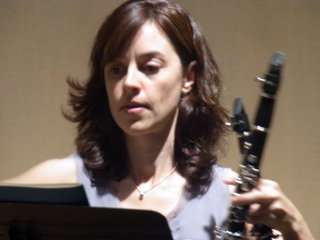|
Back
Writing Round The Moon New York
Austrian Cultural Forum, 11 East 52nd Street
09/12/2010 -
“Lunar Movements”
Gérard Pesson: The light has not the arms to carry us, for piano
Joshua Fineberg: Tremors for piano
Beat Furrer: Invocation Vi, for contrabass flute and singer
Arnold Schoenberg: Pierrot Lunaire Book 1
Pierre Boulez: Improvisé pour le Dr. K, for flute, clarinet, piano, violin, and cello
Roberto Sierra: Cancionero Sefardi (Sephardic Songs), for mezzo-soprano, flute, piano, violin, and cello
Fabien Lévy: From A Propos
Argento Chamber Ensemble: Sharla Nafziger (Soprano), Erin Lesser (Flute), Carol McGonnell (Clarinet), Joanna Chao (Piano), Miranda Cuckson (Violin), Gregory Hesselink (Cello), Michel Galante (Conductor)

S. Nafziger (© Herring Rollmop)
As the first of 13 concerts with the subtitle, “A Constellation of Contemporary Music Orbiting Pierrot Lunaire”, one expects to be cerebrally moved rather than emotionally exalted by the austere, highly accomplished Argento Chamber Ensemble. While conductor Michel Galante is a charming interlocutor and a splendid conductor, the nine core members of Argento have had the purpose, since their formation in 2000, of “performing compositions embodying pressing concerns in Western music.” (Italics mine)
As Schoenberg’s Pierrot Lunaire approaches its 1912 centenary, celebrating the work is obviously in the cards. But this music was hardly the turning point of the Schoenberg catalogue. It’s a wonderful piece of surrealistic cabaret, the wanderings of an apparently lunatic (pun intended) mind, and delightful listening. But it was difficult to align the six composers here with its progenitor.
Mr. Galante did try to make it easy. Like the markings of a Thai restaurant menu, showing degrees of spiciness, each work was prefaced with a symbol showing whether is was a “structurally rich and innovative work”, “a composition in an intuitive style” or “music from other music.”
This was amusing, but hardly enlightening. And since I was unable to attend the following short symposium, I could only hear the music as written. And (to return to the beginning), I was surprisingly emotionally moved by two of the works.
Roberto Sierra’s Sephardic Songs, sung by Sharla Nafziger with the breathtaking line of Dawn Upshaw, made these seven melodies utterly bewitching. The style and form were exactly those of Berio’s Folk Songs, one melody, augmented and embellished by a group of chamber players.

C. McGonnell (© Herring Rollmop)
Particularly exciting, though, was the concordance of Jewish, Moorish and Spanish motifs. Yes, one heard the Jewish klezmer clarinet (finely tootled by Carol McGonnell) and the Arabic octaves by all the instruments, as well as the Spanish jumping rhythms at times. But personally it brought me back to Morocco, also a trilogy of these cultures, and the music gave it emotional meaning.
I was equally entranced by the second of Fabien Lévy’s two works, When Jeff Wall Sees Hokusaï. Mr. Wall is a photogapher inspired by the woodprints of the Japanese artist–as was Debussy, whose famous cover picture of La Mer was the Hokusaï Wave. This French composer made work of long spaces, with clarinet and flute a semi-tone apart, breathily imitating the Japanese flute. One could see the woodcut while hearing the almost motionless music.
The first work by Beat Furrer, a work for contrabass flute and singer, was titled Invocation Vi, but this was a joke. The work was obviously an image of copulation. (Not a bad subject for Mr. Schoenberg, whose early works breathed sex!) Erin Lesser played the contrabass flute, an instrument I had neither seen nor heard before. But the notes were few at the start. Instead, they were edge-of-tone breathing and trilling, while Ms. Nafziger simply muttered tones. As the piece continued, the breaths became notes, the tones became tunes, the music became louder and louder, higher and higher , to a feverish climax…..and then quiet again…..the breaths, the wordless whispers.
Perhaps it wasn’t the act of sex. But it sure fooled me! (I expected them each to take out a cigarette and puff before moving on.)
Pesson’s The Light has Not The Arms to Carry Us used barely audible piano rhythms around real tones. Mr. Fineberg’s Tremors gave the piano a Messiaenic flavor. Chaotic, propelled, percussive.
Finally came Boulez’ homage to his publisher, Doctor Kalmus, and then, the work of the evening, the first seven works from Pierrot Lunaire. I have heard them sung more freely, with more ”nachtclub” style sharpness and irony. But the precision of the Argento ensemble, and Ms. Nafziger’s pitch-perfect rendition were satisfying enough.
Harry Rolnick
|